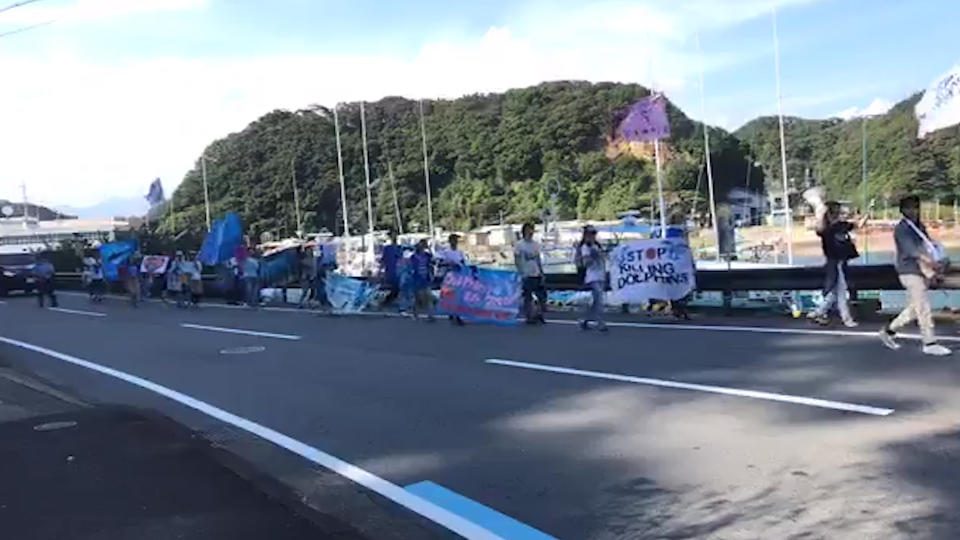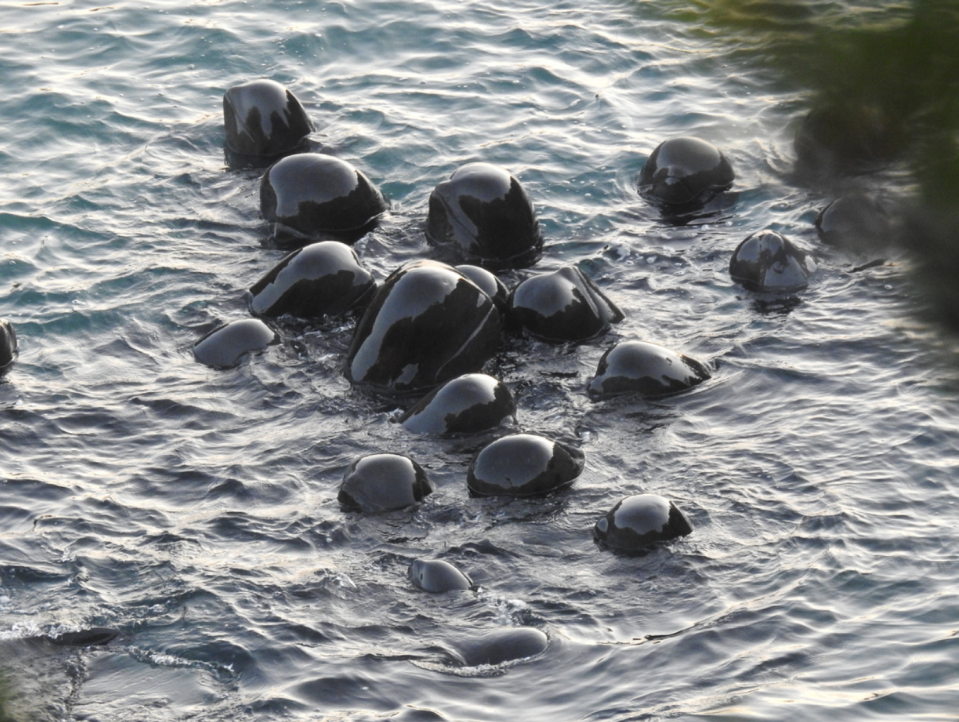'You listen to them die': Horrific story behind dolphin activist's collection of rocks
When dolphin activist Rachel Carbary returns home from a trip to Japan, she hopes to be carrying as few rocks as possible.
Each one represents a pod of dolphins or whales she has watched “be ripped apart” by hunters in the town of Taiji, 420km southwest of Tokyo.
Ms Carbary volunteers for Ric O’Barry’s Dolphin Project, travelling to Japan on a regular basis to document the yearly dolphin drives at a beach known as The Cove.

“I select a rock from the beach at The Cove that stands out to me, that can serve as a memory of the pod,” she told Yahoo News Australia.
“It’s just something I do for myself, it’s part of my coping and memory of the situation.”
This year, Ms Carbary was in Taiji for two weeks where she witnessed what she calls six “red cove days” – a reference to the water being soaked in dolphin blood.
‘You listen to them die’
Her first “red cove” day this year occurred on September 2 and involved a pod of her favourites – a family of striped Risso’s dolphins.
When the skiffs drove the animals into the cove, she was unsure if they’d be slaughtered, captured for the entertainment industry, or sent back out to sea.
“They literally fought for their lives, like all the pods do,” she said.
“When they were driven into the cove, and they were slaughtered, we stand up on that hill and we document as best we can the situation.”

The hunters hide behind tarpaulins to block the bloody slaughter from the video cameras.
“You listen to them die, you listen to them thrash in the water as they’re being killed,” she said.
“And then it goes completely silent on the shore, so you know that entire family is dead.
“You see these once beautiful … this family that was swimming wild and free in the ocean … you know a few hours later their bodies are dead and floating on the surface of the water, being hauled off and processed for meat.”

Trainers arrive before slaughter to select dolphins
Three pods of bottle-nosed dolphins – the type made popular by the 1960 television show Flipper – are scrawled across Ms Carbary’s next three rocks.
Activist Lincoln O’Barry, the son of former Flipper trainer Ric O’Barry, has seen the selection process first hand.
“They’re looking for that perfect bottle-nosed dolphin,” he told Yahoo News Australia.
“They’ve got breeding and other things in mind – so a lot of times they’re looking for young females.
“Orders have already been made at the beginning of the season and they’re fulfilling those orders.”


Mr O’Barry said trainers arrived hours before the slaughter to select the dolphins they want.
“If you didn’t have the captivity angle, you wouldn’t have the slaughter any more – it’s just not worth it,” he said.
“The money is all being made from the captivity industry.”
Growing movement in Japan against slaughtering
Another pod of Risso’s dolphins were herded into the cove on September 9, with Ms Carbary witnessing some of the younger ones taken away for the aquarium industry.
The rest of the family were killed.
She said most Japanese were unaware of the annual slaughter, but there was a growing local protest movement.


This year on September 1, there was a march through Taiji opposing the hunt.
Ms Carbary witnessed the group show up and say “enough is enough”.
“They had banners, and signs and a loud speaker,” she said.
“The movement in Japan is really growing and that’s an important thing.”
Authorities raid Bali hotel to rescue dolphins from concrete enclosure
'Dirty secrets' of dolphin tourist parks revealed as 'abuse' video emerges
'Alarming' photographs show 'sewage' spilling into dolphin pens
Water turns ‘red from the blood’
Ms Carbary witnessed on September 10 and 11 her final drive for the season – a pod of pilot whales.
“They’re always the most horrific ones to witness,” she said.
“Pilot whales, they’re always close to each other.
“They’re just constantly swimming right along side each other, rubbing up against each other, almost as if they’re comforting each other.”
The pod was chased until they were exhausted and then left over night.
The following morning, Ms Carbary watched as the hunters returned.
“They took the smaller, younger members of this nursery pod for captivity, and then they began the slaughter process,” she said.
“On that particular day, they actually started the slaughter process before all the captives were even out from underneath the tarps.


“So we had younger members of that family trapped in slings now witnessing their family being killed in front of them.
The killing took place under tarpaulins so Ms Carbary could hear, but not always see the “horror”.
“You can hear them splashing, you can see the water starting to turn red from the blood,” she said.
“The interesting thing was, when they got to the last, it almost seemed like the thrashing wasn’t as loud any more.
“It’s like maybe they just gave in, they just accepted their fate.
“They had just watch their entire family be destroyed in front of them.”
Ms Carbary plans to return to Taiji.
The International Marine Animal Trainer's Association has been contacted for comment.
Do you have a story tip? Email: newsroomau@yahoonews.com.
You can also follow us on Facebook and Twitter, download the Yahoo News app from the App Store or Google Play and stay up to date with the latest news with Yahoo’s daily newsletter. Sign up here.



